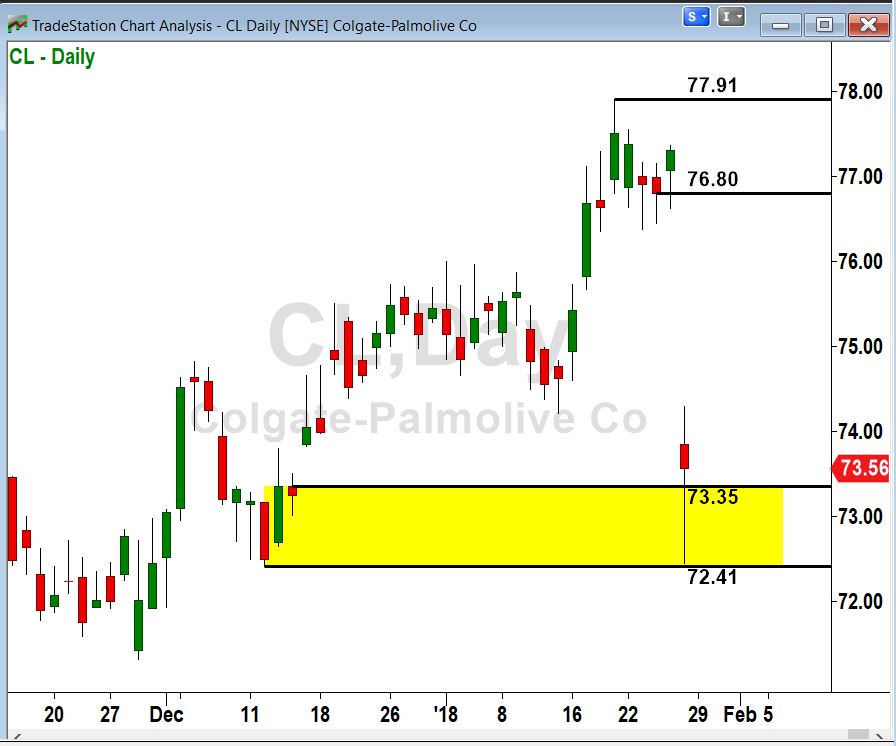I have referred often in these articles to the Options Profit Loss graph. Today, I want to show it explicitly and discuss its uses.
First, let’s look not at an option Profit Loss graph, but at a regular price chart of a stock to use an example. I’ve chosen Colgate Palmolive (symbol CL).
On this date, Colgate had just reported in-line earnings but disappointing sales, and its stock price had dropped by over 6% in a single day.
In cases of earnings surprises like this, it is often true that the immediate move is an overreaction that will be reversed in the near future. This could very well be one of those cases. The stock seemed to have stopped its plunge and begun righting itself.
To capitalize on the rebound move, we could have bought call options. These would increase in value if Colgate stock went back up. Checking the option chain, we found that the May call at the $70 strike could be bought for $4.875 per share ($487.50 per option contract).
How much might we expect to make if we bought those calls and were right about CL regaining its pre-earnings price in the near future?
Answering that question requires an options profit loss graph. Although we know that a call option will go up in value when its underlying stock does, the movement is not linear. There is no back-of-the envelope way to calculate what an option price will be after a move in the stock price. We need the mathematical horsepower of the option profit loss graph to do it. All trading platforms provide some version of this tool. The details of their operations are a little different, but all are basically similar in their function.
That function is to show us how much money could be made or lost on an option position, when its underlying stock moves to a different price.
Below is the option P/L graph for the May $70 CL Calls, made as of January 28, 2018.
This diagram is actually three P/L graphs (the thin white, purple and cyan lines that slope upward from left to right). Each of the three lines is calculated as of a different date. This is to show that the price of an option is affected not just by stock price, but also by time. I selected the current date (1/28/18, white line); another date about two months away (3/24/18, purple line); and the expiration date (May 18, 2018, cyan line).
The three graphs all take $487.50, the current market value of the option, as its initial cost. Each line plots the profit or loss that would be made on the option if liquidated on the date specified for that line, with the stock at that time at the price indicated on the horizontal axis.
The graphs take a little getting used to, but the effort is well worth it. The stock price, instead of being on the vertical axis like a price chart, is on the horizontal axis. And the vertical axis shows profit or loss from a fixed starting point (the $487.50 current value of the options).
In the table beneath the graph, on the bottom line, is a row of data that would apply if the stock price were to rise to $81.08 today. We can tell this because $81.08 is the amount shown in the first column, labeled Price; and because under the heading “Plot” the value is “Plot 1.” Today’s date (1/28/18) is shown as the first of the three dates in the legend on the chart, in the box (plot number 1). In the “Value” column for this line, the amount shown is $1,142.37. This means that if CL stock were to rise to $81.08 today, the value of our $70 strike call option would be that amount. Since our cost is $487.50, our profit would be $1,142.37 – $487.50, or $654.87. We can see that the amount under the heading “Theo P/L” is $654.87.
I chose $81.08 as an example price, called a price ‘slice,’ just because it was a high price that would be unlikely to be reached today. Notice that there are two other rows of data in the table. These are for the current price ($73.87) and a price that is much lower ($67.30). In fact, you can show as many price slices as you want and specify a different price for each.
On the row whose Price is $67.30, we can see that the Value of the option would be only $110.71. Since our cost was $487.50, that would represent a loss of $487.50 – $110,71, or $376.79. That amount is shown in the “Theo P/L” column for that line.
Usually, we use three slices: one for the price at which the stock is now; one for the stop-loss price, and one for a target price. The Value column then shows us what the value of the option position would be with the stock at each of those prices. We can then evaluate risk vs. reward on the trade to determine if we should take it.
That’s all we have space for today. There is much more that the profit loss graph can do, and we’ll look at some of those features in future articles. If you trade options, be sure to become fluent in the use of the P/L graphing tool that comes with your platform
This content is intended to provide educational information only. This information should not be construed as individual or customized legal, tax, financial or investment services. As each individual's situation is unique, a qualified professional should be consulted before making legal, tax, financial and investment decisions. The educational information provided in this article does not comprise any course or a part of any course that may be used as an educational credit for any certification purpose and will not prepare any User to be accredited for any licenses in any industry and will not prepare any User to get a job. Reproduced by permission from OTAcademy.com click here for Terms of Use: https://www.otacademy.com/about/terms
Editors’ Picks

EUR/USD accelerates losses to 1.0930 on stronger Dollar
The US Dollar's recovery regains extra impulse sending the US Dollar Index to fresh highs and relegating EUR/USD to navigate the area of daily troughs around 1.0930 in the latter part of Friday's session.

GBP/USD plummets to four-week lows near 1.2850
The US Dollar's rebound keep gathering steam and now sends GBP/USD to the area of multi-week lows in the 1.2850 region amid the broad-based pullback in the risk-associated universe.

Gold trades on the back foot, flirts with $3,000
Gold prices are accelerating their daily decline, steadily approaching the critical $3,000 per troy ounce mark as the Greenback's rebound gains extra momentum and US yields tighten their retracement.

Can Maker break $1,450 hurdle as whales launch buying spree?
Maker holds steadily above $1,250 support as a whale scoops $1.21 million worth of MKR. Addresses with a 100k to 1 million MKR balance now account for 24.27% of Maker’s total supply. Maker battles a bear flag pattern as bulls gather for an epic weekend move.

Strategic implications of “Liberation Day”
Liberation Day in the United States came with extremely protectionist and inward-looking tariff policy aimed at just about all U.S. trading partners. In this report, we outline some of the more strategic implications of Liberation Day and developments we will be paying close attention to going forward.
RECOMMENDED LESSONS
Making money in forex is easy if you know how the bankers trade!
Discover how to make money in forex is easy if you know how the bankers trade!
5 Forex News Events You Need To Know
In the fast moving world of currency markets, it is extremely important for new traders to know the list of important forex news...
Top 10 Chart Patterns Every Trader Should Know
Chart patterns are one of the most effective trading tools for a trader. They are pure price-action, and form on the basis of underlying buying and...
7 Ways to Avoid Forex Scams
The forex industry is recently seeing more and more scams. Here are 7 ways to avoid losing your money in such scams: Forex scams are becoming frequent. Michael Greenberg reports on luxurious expenses, including a submarine bought from the money taken from forex traders. Here’s another report of a forex fraud. So, how can we avoid falling in such forex scams?
What Are the 10 Fatal Mistakes Traders Make
Trading is exciting. Trading is hard. Trading is extremely hard. Some say that it takes more than 10,000 hours to master. Others believe that trading is the way to quick riches. They might be both wrong. What is important to know that no matter how experienced you are, mistakes will be part of the trading process.

The Best brokers to trade EUR/USD
SPONSORED Discover the top brokers for trading EUR/USD in 2025. Our list features brokers with competitive spreads, fast execution, and powerful platforms. Whether you're a beginner or an expert, find the right partner to navigate the dynamic Forex market.


